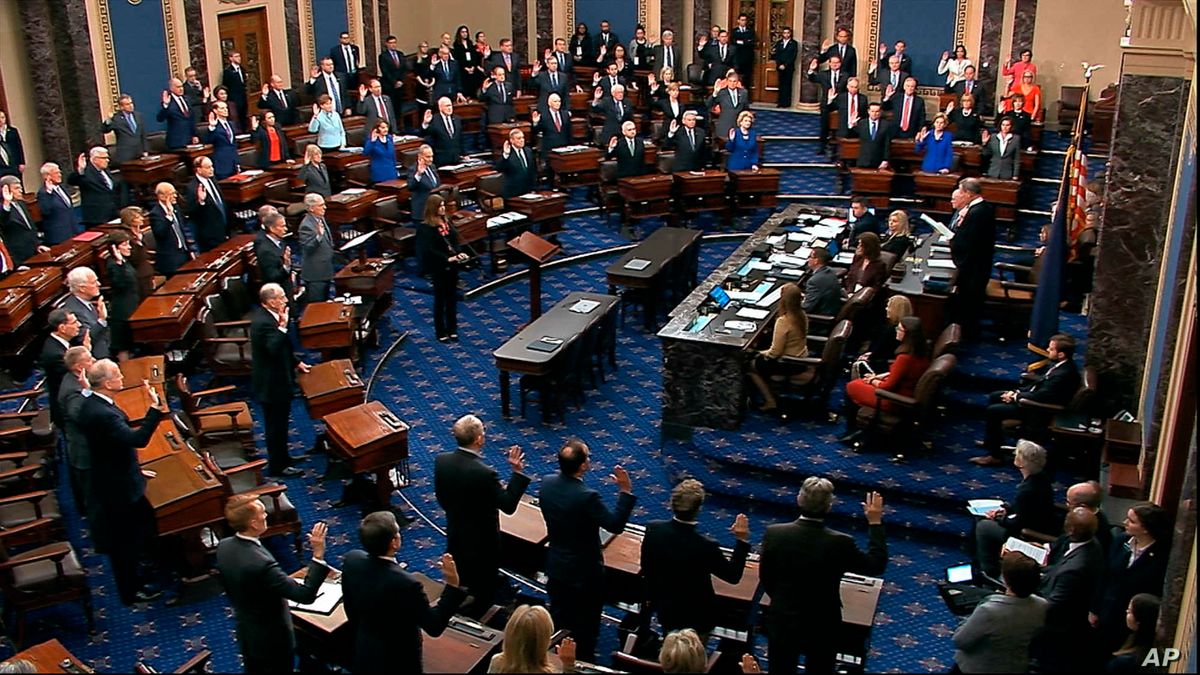Senate looking to limit press access during the Trump impeachment trial

A few minutes every morning is all you need.
Stay up to date on the world's Headlines and Human Stories. It's fun, it's factual, it's fluff-free.
The impeachment trial of US President Donald Trump began Tuesday in the Senate. Journalists are pushing back against proposed rules that would limit press access.
Here is a look on previous impeachments to understand the role the press can play in the procedures.
A limit on access and electronic devices
As reported by Roll Call last week, proposed rules for enforcing security during the impeachment trial are resulting in an “unprecedented crackdown” on members of the press. In addition to security screenings for everyone entering the building, the proposed rules are set to limit where journalists can move within the Senate and prevent them from bringing in electronic devices.
Journalists are generally permitted to move freely in the hallways and corridors of the Senate, according to The New York Times. This allows them to directly interact with senators as they cross from their offices to the Senate chambers, where the Senate performs its legislative duties. However, during the impeachment trial, journalists are reportedly restricted to roped-off pens.
Additionally, C-SPAN, the nonprofit television station that airs many congressional hearings for free, was not permitted to film the trial. As of the reporting of this story, the only video cameras permitted in the chambers will be those controlled by the government, which limits what the public can see.
While journalists are never allowed in the chamber, a press gallery allows them a bird’s eye view of the proceedings. Phones and laptops are normally forbidden in the press gallery, but representatives for the press petitioned to be allowed electronic devices during the impeachment proceedings. Their request was rejected, and security is reportedly using a magnetometer to scan for electronics.
[article_ad]
Reaction to the rules
The restrictions have been called “ludicrous” and unnecessary by journalists and challenged by both the Standing Committee of Correspondents and the American Civil Liberties Union (ACLU). They argue the greater security needs don’t justify hampering the freedom of the press.
In a letter to Senate leaders, the ACLU stated that “transparency in an impeachment trial” is in the public interest. They called for journalists to have unrestricted access and to be allowed to use laptops and phones. They also argued that video cameras should be allowed in the chamber.
As the ACLU notes in its letter, the Senate has spent the last half-century moving toward greater transparency and press freedom. The first television broadcast from within the Senate occurred in 1974, while C-SPAN launched in 1986. Today, online livestreams are often common.
How to watch the impeachment trial
With the impeachment of President Trump being one of the biggest news stories of the moment, there is considerable interest in the trial to the point that CNN ran an article about how to watch it. The first order of business was voting on the rules for the trial, a process that took 13 hours. After that, each subsequent day of the trial is expected to last from 1 to 6 p.m.
Once the trial begins, there will be limited means for how the general public can watch the proceedings.
C-SPAN has set up a page on its website for showing all impeachment-related matters. They promise to provide footage from the trial, but it’s uncertain at this time whether that will be video from their own cameras or from government-controlled cameras.
PBS NewsHour will air the proceedings on YouTube and MSNBC will be covering the story live. Spectators may also be able to get tickets to view the proceedings in person through various Senate offices.
[article_ad]
Historical precedents for Trump’s impeachment trial
Before Trump, only two other presidents – Andrew Johnson in 1868 and Bill Clinton in 1998 – had been impeached. President Richard Nixon resigned before he could be impeached by the House, but hearings into the so-called Watergate Scandal became “must-see” television in the US, according to The Washington Post.
The Senate Watergate Committee hearings were televised during the summer of 1973 and brought all the details to the public via the three major TV networks at the time, ABC, NBC, and CBS.
Of particular note was the five-day testimony of John Dean, the White House counsel under Nixon. His testimony, which implicated Nixon in the break-in at the Watergate hotel and subsequent cover-up, was said to be what brought the president down and ultimately forced him to resign before an impeachment trial.
As the Washington Post reported, the impeachment trial of Clinton, which took place in January and February 1999, was televised. However, the biggest television moments had already occurred prior to the trial.
One of the most memorable moments was a January 1998 press conference in the White House’s Roosevelt Room. In the press conference, President Clinton famously insisted, “I did not have sexual relations with that woman, Miss Lewinsky.”
That assertion would ultimately be challenged as independent counsel Ken Starr investigated, among other things, whether Clinton had lied under oath regarding a sexual relationship with former White House intern, Monica Lewinsky.
More than a century earlier, President Johnson was impeached for defying a Congressional act, thereby breaking the law. His trial occurred well before the advent of television, but the public could get a ticket in order to watch.
Both Clinton and Johnson were ultimately found not guilty in their impeachment trials.
[article_ad]




Comments ()